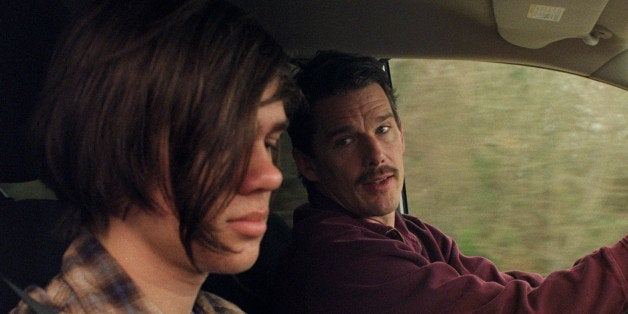
Do not get me wrong. I love rules. Rules keep things organized and stop people from going down the "Up" stairs at school and from letting people leave their dog's poop in my yard. But, after seeing the intriguing trailer for Richard Linklater's R-rated Boyhood, the only thought stirring in my best friend's and my heads was "We HAVE to sneak into this movie."
As we painstakingly waited for the film to open in our city, I perused articles about the film with light speed and learned even more enticing facts about the film, like how it was filmed one month out of every year for 12 years. By the time the curiosity-striking film opened, it already had a perfect 100 rating on IMDB. I practically longed to find something wrong with it, mostly to be viewed as a provocateur, but also to get back at the movie in my mind for taking so long to open here.
Now, 10 days after seeing the movie for the first time, praiseful thoughts for the film and new connections still swirl through my mind every day. For every flaw I struggled to find while I watched it with wide, wonder-filled eyes, each flaw was clearly justified. The only thing that bothers me is that if there is a sequel it will take at least 12 years before I get to see it.
I don't even know where to begin. Well, the first thing I noticed as a camera zoomed in on a 7-year-old Ellar Coltrane was the song "Yellow" by Coldplay setting the scene. The song not only captured the spirit of the film with its gentle grace, but was pretty accurate as a popular song for the time period because filming started in summer 2002. From little Lorelei Linklater singing "Baby One More Time" to the two kids and their stepsiblings going to the late night release of the book Harry Potter and the Half-Blood Prince, every cultural and musical nod is slick and spot-on.
Also, another flaw I tried to find was with my immediate disdain for the sequence of the mother, Olivia, marrying her professor and coming home to a seemingly-perfect house with new step-siblings already calling her "Mom." I thought I found my flaw as the newlyweds told the story of throwing a paper airplane off the Eiffel Tower to a table of four kids, two pairs of matching genders, ages and interests. I simply shrugged as the husband ordered another glass of wine. As time rolled on (SPOILER ALERT), the reveal of the husband's alcoholic and abusive qualities' purpose was clear as it only made the crumbling of their marriage and lavish lifestyle even more painful for me. Also, it made Mason and Samantha's biological father, who had been completely absent for over a year, look even better in his pure-intentioned attempt to reconnect with his kids.
I can only dream of catching a fraction of them, but I noticed connections on connections through this two-hour and forty-five minute epic. As the audience makes these connections, it makes the Evans family feel realer and realer, almost like one is stealing glances at a family's photo album or watching a collection of home movies. For example, some characters subtly recur. One year, junior-high age Mason chats with a girl on a bike as they stroll through an alley. Then, on the night of his fifteenth birthday, he gets out the back window of a station wagon on a dark night after making out with her. Her identity is made clear after she cheerily offers him a piece of gum to cover up his severe pot breath. Also, when a worker who knows little English is fixing the family's piping, the mother casually tells him that he is smart and should go to school. Years later, he covers their meal at the restaurant he now manages and thanks her for her life-changing advice that encouraged him to go to college.
There are patterns too, observed as characters become more and more distinct and evolve. One obvious one is how the mother falls in love with her college professor. Then later, she becomes a college professor herself and falls in love with a student of hers. Also, in Mason and Samantha's childhood, a car ride with their dad involved him scolding them for being vague and minimal in answering questions because he did not want to be "that dad," then them proposing that he talk a little more about himself too and them all agreeing that the conversation should just become natural. Flash-forward to Mason's seventeenth year, and a FaceTime call includes a completely organic conversation with both parties voluntarily elaborating. Those little things just show how much people affect each other and what a moment can do to a lifetime.
I conclude that Boyhood is more of an experience than a movie. It is kind of like watching one of those sped-up videos of a flower blooming, but instead of you sitting there thinking, "What the heck just happened?" every few seconds the video is paused and someone gently points you to the areas where things have majorly changed, but lets you catch the smaller changes too. Often, people's actions, style and words seem to come out of nowhere, but Boyhood reminds us that everyone had a childhood with different excesses, voids, villains and heroes and this chronicle of moments forms a person.